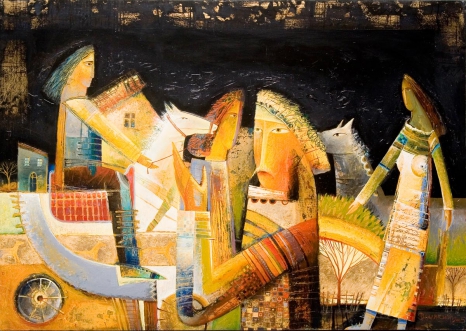
Dialogue - Roman Opalinski
16 July – 15 August 2006
The beginning of 1990, marked by Ukraine’s gaining of independence, gave many Ukrainian artists the impetus to actively search for new themes and images and to find their own place in the contemporary artistic process. It also perceptibly revitalised their dialogue with the European art world.
It was during this time that the creative talent and potential of the Lviv painter Roman Opaliński became particularly evident.
To his own surprise, he discovered the convergence of many of his artistic ideas, even those from his student years, with new social and aesthetic criteria – especially those prevailing in the artistic circles of a democratic European society. He sensed that he could create freely and express his thoughts without restraint. Without the slightest hesitation, the artist turned to a fundamental and distinctive theme in his work, focusing on Ukraine, its historical and contemporary heroism, while moving within his characteristic style of creating (or interpreting) painted images, forms, and motifs.
Roman Opaliński was born in the small town of Gródek near Lviv, which, especially during snowy winters, captivates with its extraordinary, unique landscape plasticity and pastel colors. The influence of the natural environment and the familiar landscape of the Lviv region became significant for the creative nature and worldview of the artist, for whom, even from childhood, the harmony between man and the natural environment was one of the most important means of shaping his personality. During his student years, Opaliński was fascinated by Old Russian icons and Ukrainian folk art. Equally important sources of inspiration were the works of original and highly esteemed European artists, such as the Impressionists, to whom he still turns today.
Symbolism and allegory form the original painted world of Roman Opaliński’s work, whose internal processes are often hidden and require special attention, emotion, and, above all, a desire to participate in the creative act that invariably evolves in each piece or creates a unique creative aura around it. Beyond painting, he is captivated by the plastic possibilities of artistic blacksmithing, the idea of synthesizing the artistically expressive means of painting on wood with metalworking, an original compositional blend of graphically precise lines of metal filigree and forged elements with dominant painted fragments.
Examples of this are the triptychs “New Countdown” and “Under the Cloud”, where the artist, using his unique allegorical and symbolic key, addresses the difficult issues of contemporary Ukrainian existence or the question of its cultural potential. The titles of most of his works serve as a kind of “protective shell,” beneath which lies deep and emotional content, expressed by the artist through his own unique painterly and plastic means.
Ihor Hołod
Professor at the Lviv National Academy of Arts
Reprint from the catalog Roman Opaliński: “Dialogue. Painting. Artistic Blacksmithing.”